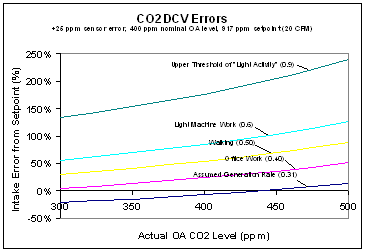[an error occurred while processing this directive]
AutomatedBuildings.com
|
[an error occurred while processing this directive] |
| May
2003 Article: Ventilation Codes ICC's International Mechanical Code vs. NFPA 5000, Analysis and Recommendations Leonard A. Damiano, V.P. Sales & Marketing, Ebtron, Inc Response
to May Article: Rebuttal |
Automatedbuildings.com
May 22, 2003
Dear Ken:
This is my response to Mr. Schell's comments.
I was aware of the Commentary and suggest that Mr. Schell re-read the quotation that he included in his letter. It says: ... "carbon dioxide (CO2) detectors can be used to ….. estimate the occupant load of the space". There is a big difference between estimating the occupant load and confirming the rate of intake at the air handler, particularly when coupled with "under any load condition" as required by ASHRAE 62-2001.
|
[an error occurred while processing this directive] |
The IMC Commentary quoted by Mr. Schell does not say to use CO2 to control ventilation rates, but properly limits the role of CO2 to "estimating occupancy" -- against which the ventilation rates needed for compliance can be reset for control, when allowed under variable conditions. It is the means of establishing the ventilation rate in the first place that is the problem in Mr. Schell's interpretation.
I have already written about the issues involved with CO2 direct control of ventilation rates and would refer anyone interested to Demand-Controlled Ventilation" (DCV) and Intake Rate Control in the automatedbuilding.com's archives. It details some of the many problems DCV can have, like:
the 3 huge assumptions required for the "steady-state" concentration balance equation to provide valid results, the meaning and intent of ASHRAE 62;
the inability CO2 to satisfy the Multi-space equation; effect of CO2 measurement error on intake setpoint error;
effect of intake setpoint errors on pressurization and humidity control, the low outside temperature limitations of CO2 measurement technology;
effect of outside CO2 variability;
effect of population density on DCV calculations and setpoint error;
effect of applying multiple CO2 sensors; and
effect of variable respiration rates on intake setpoint errors.

Mathematical modeling has shown intake setpoint errors can range from about -20% to +200%, merely with changes in the activity level of the occupants and the variability of outside CO2 levels (due to seasonality, geography, and uncontrolled external activities.)
DCV using CO2 tends to over ventilate and is not the energy savior that it is touted to be, when evaluated against anything other than a worst-case intake rate. Direct methods of control with reset for variable conditions are vastly superior to all indirect means of control.
I can not agree to the conclusion that CO2 measurements can provide "a direct measure of the outside air dilution rate of the space." I guess some will always ignore the limiting conditions in the use of CO2 for DCV in non-residential applications.
Sincerely,
![]()
Len (not Lou) Damiano,
Vice President - Sales & Marketing
Ebtron, Inc
[an error occurred while processing this directive]
[Click Banner To Learn More]
[Home Page] [The Automator] [About] [Subscribe ] [Contact Us]